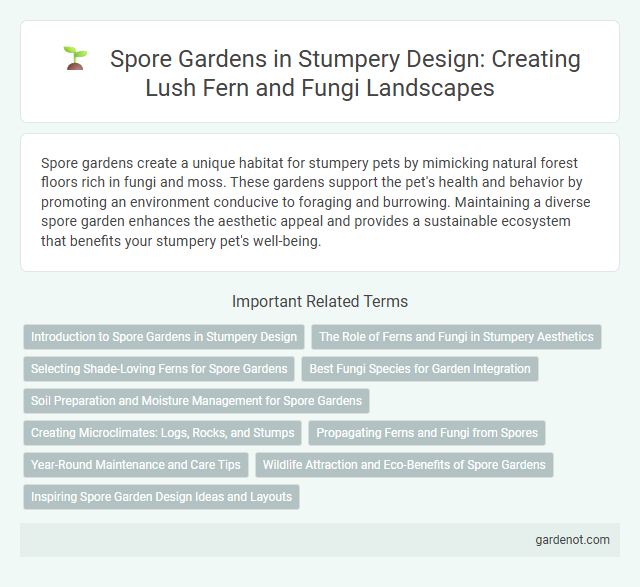Spore gardens create a unique habitat for stumpery pets by mimicking natural forest floors rich in fungi and moss. These gardens support the pet's health and behavior by promoting an environment conducive to foraging and burrowing. Maintaining a diverse spore garden enhances the aesthetic appeal and provides a sustainable ecosystem that benefits your stumpery pet's well-being.
Introduction to Spore Gardens in Stumpery Design
Spore gardens are a unique feature in stumpery design, showcasing the intricate beauty of fungal spores growing on decaying wood and organic matter. These gardens emphasize biodiversity by creating microhabitats that support various fungi species, contributing to natural decomposition and nutrient cycling. Incorporating spore gardens enhances the ecological value of stumperies while adding textural contrast and seasonal interest.
The Role of Ferns and Fungi in Stumpery Aesthetics
Ferns and fungi play a crucial role in stumpery aesthetics by creating lush, textured layers that enhance naturalistic displays. Their diverse shapes and vibrant colors contribute to the visual complexity and organic feel of spore gardens, fostering a rich, biodiverse microhabitat. These elements not only provide structural interest but also support ecological balance by promoting moisture retention and nutrient cycling within the stumpery ecosystem.
Selecting Shade-Loving Ferns for Spore Gardens
Selecting shade-loving ferns such as Polystichum, Athyrium, and Dryopteris enhances the spore garden's texture and supports spore dispersal in low-light environments. These ferns thrive in moist, well-drained soil conditions typical of shaded woodland areas, promoting healthy rhizome growth and sporangia development. Incorporating native shade ferns also encourages biodiversity by attracting spore-dispersing insects and maintaining natural forest ecosystem functions.
Best Fungi Species for Garden Integration
Choosing the best fungi species for garden integration involves selecting spore-producing mushrooms like shiitake (Lentinula edodes), oyster (Pleurotus ostreatus), and wine cap (Stropharia rugosoannulata) that thrive in woodland garden environments. These fungi enhance soil fertility by decomposing organic matter, improving nutrient cycling, and promoting beneficial mycorrhizal relationships with surrounding plants. Incorporating spore-rich species into a stumpery creates a dynamic ecosystem that supports biodiversity and sustainable garden health.
Soil Preparation and Moisture Management for Spore Gardens
Optimal soil preparation for a spore garden involves creating a rich, organic substrate that retains moisture without becoming waterlogged. Incorporating well-rotted leaf mold, compost, and fine bark mulch ensures a loose, aerated medium supporting delicate fungal growth. Consistent moisture management, maintaining damp but not saturated conditions, promotes vigorous spore germination and healthy mycelium development in the stumpery environment.
Creating Microclimates: Logs, Rocks, and Stumps
Logs, rocks, and stumps in a spore garden create essential microclimates by retaining moisture and providing varied habitats that support diverse fungal growth. These natural elements regulate temperature fluctuations and humidity levels, fostering ideal conditions for spore germination and mycelium development. Incorporating decaying wood and stone structures enhances biodiversity by mimicking woodland ecosystems, promoting healthy fungal proliferation.
Propagating Ferns and Fungi from Spores
Spore gardens offer an ideal environment for propagating ferns and fungi by replicating their natural spore dispersal and germination processes. Maintaining high humidity and filtered light encourages the development of delicate fern gametophytes and fungal mycelium, essential stages in their life cycles. Utilizing a sterile substrate enriched with organic matter promotes successful spore colonization and growth, enhancing biodiversity within the stumpery.
Year-Round Maintenance and Care Tips
A spore garden in a stumpery requires consistent moisture and indirect light to promote healthy fungal growth throughout the year. Regularly removing debris and monitoring humidity levels prevents mold and pests, ensuring a thriving ecosystem. Incorporating native mosses and shade-loving plants enhances the habitat, supporting diverse spore propagation and sustainability.
Wildlife Attraction and Eco-Benefits of Spore Gardens
Spore gardens create a unique habitat that attracts diverse wildlife, including fungi-feeding insects, small mammals, and birds that rely on spores for nutrition and shelter. These gardens enhance local biodiversity by supporting complex fungal networks essential for nutrient cycling and soil health. Eco-benefits include improved soil fertility, natural pest control, and increased carbon sequestration through the symbiotic relationships fostered by fungal spores.
Inspiring Spore Garden Design Ideas and Layouts
A stunning spore garden features strategically arranged logs, moss, and ferns to create a natural woodland habitat encouraging diverse fungi growth. Incorporating varied textures and heights enhances visual interest while promoting optimal spore dispersal across shaded, moist areas. Thoughtful pathways and layered plantings support fungal biodiversity, turning the spore garden into an inspiring outdoor laboratory for mycology enthusiasts.
Spore garden Infographic

 gardenot.com
gardenot.com